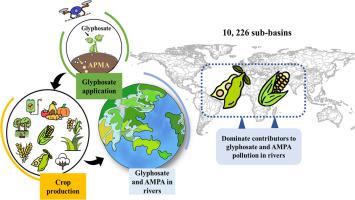当前位置:
X-MOL 学术
›
Water Res.
›
论文详情
Our official English website, www.x-mol.net, welcomes your feedback! (Note: you will need to create a separate account there.)
A global assessment of glyphosate and AMPA inputs into rivers: Over half of the pollutants are from corn and soybean production
Water Research ( IF 11.4 ) Pub Date : 2024-06-21 , DOI: 10.1016/j.watres.2024.121986 Qi Zhang , Yanan Li , Carolien Kroeze , Wen Xu , Lingtong Gai , Miltiadis Vitsas , Lin Ma , Fusuo Zhang , Maryna Strokal
Water Research ( IF 11.4 ) Pub Date : 2024-06-21 , DOI: 10.1016/j.watres.2024.121986 Qi Zhang , Yanan Li , Carolien Kroeze , Wen Xu , Lingtong Gai , Miltiadis Vitsas , Lin Ma , Fusuo Zhang , Maryna Strokal

|
Glyphosate is widely used in agriculture for weed control; however, it may pollute water systems with its by-product, aminomethylphosphonic acid (AMPA). Therefore, a better understanding of the flows of glyphosate and AMPA from soils into rivers is required. We developed the spatially explicit MARINA–Pesticides model to estimate the annual inputs of glyphosate and AMPA into rivers, considering 10 crops in 10,226 sub-basins globally for 2020. Our model results show that, globally, 880 tonnes of glyphosate and 4,090 tonnes of AMPA entered rivers. This implies that 82 % of the river inputs were from AMPA, with glyphosate accounting for the remainder. Over half of AMPA and glyphosate in rivers globally originated from corn and soybean production; however, there were differences among sub-basins. Asian sub-basins accounted for over half of glyphosate in rivers globally, with the contribution from corn production being dominant. South American sub-basins accounted for approximately two-thirds of AMPA in rivers globally, originating largely from soybean production. Our findings constitute a reference for implementing and supporting effective control strategies to achieve Sustainable Development Goals 2 and 6 (food production and clean water, respectively) simultaneously in the future.
中文翻译:

对河流中草甘膦和 AMPA 输入的全球评估:超过一半的污染物来自玉米和大豆生产
草甘膦在农业中广泛用于控制杂草;然而,它的副产品氨甲基膦酸(AMPA)可能会污染水系统。因此,需要更好地了解草甘膦和 AMPA 从土壤流入河流的情况。我们开发了空间明确的海洋-农药模型,以估计 2020 年全球 10,226 个子流域的 10 种作物对河流的草甘膦和 AMPA 的年度输入量。我们的模型结果显示,全球草甘膦和 AMPA 的年输入量为 880 吨和 4,090 吨进入河流。这意味着 82% 的河流输入来自 AMPA,其余为草甘膦。全球河流中超过一半的 AMPA 和草甘膦源自玉米和大豆生产;然而,各子流域之间存在差异。亚洲次流域占全球河流中草甘膦的一半以上,其中玉米生产的贡献占主导地位。南美次流域约占全球河流 AMPA 的三分之二,主要来自大豆生产。我们的研究结果为实施和支持有效的控制策略提供了参考,以在未来同时实现可持续发展目标 2 和 6(分别是粮食生产和清洁水)。
更新日期:2024-06-21
中文翻译:

对河流中草甘膦和 AMPA 输入的全球评估:超过一半的污染物来自玉米和大豆生产
草甘膦在农业中广泛用于控制杂草;然而,它的副产品氨甲基膦酸(AMPA)可能会污染水系统。因此,需要更好地了解草甘膦和 AMPA 从土壤流入河流的情况。我们开发了空间明确的海洋-农药模型,以估计 2020 年全球 10,226 个子流域的 10 种作物对河流的草甘膦和 AMPA 的年度输入量。我们的模型结果显示,全球草甘膦和 AMPA 的年输入量为 880 吨和 4,090 吨进入河流。这意味着 82% 的河流输入来自 AMPA,其余为草甘膦。全球河流中超过一半的 AMPA 和草甘膦源自玉米和大豆生产;然而,各子流域之间存在差异。亚洲次流域占全球河流中草甘膦的一半以上,其中玉米生产的贡献占主导地位。南美次流域约占全球河流 AMPA 的三分之二,主要来自大豆生产。我们的研究结果为实施和支持有效的控制策略提供了参考,以在未来同时实现可持续发展目标 2 和 6(分别是粮食生产和清洁水)。






































 京公网安备 11010802027423号
京公网安备 11010802027423号